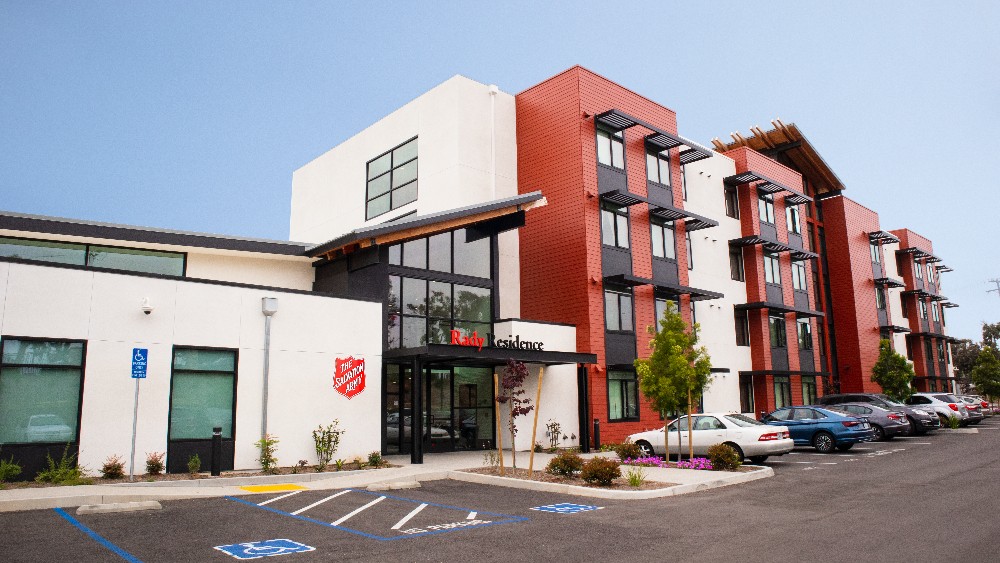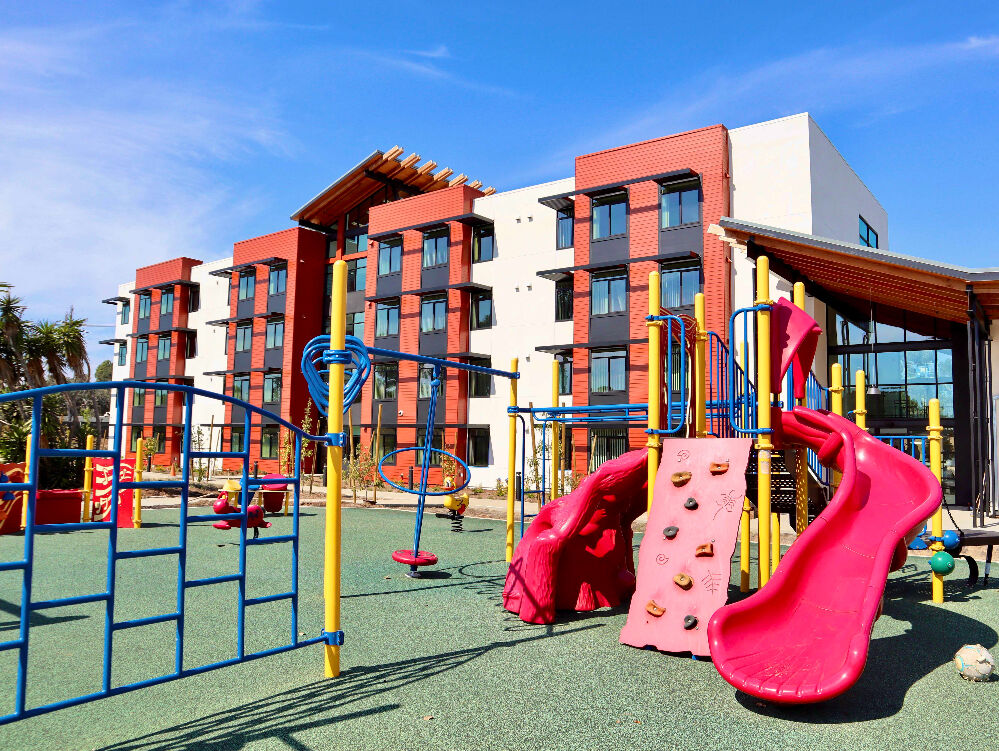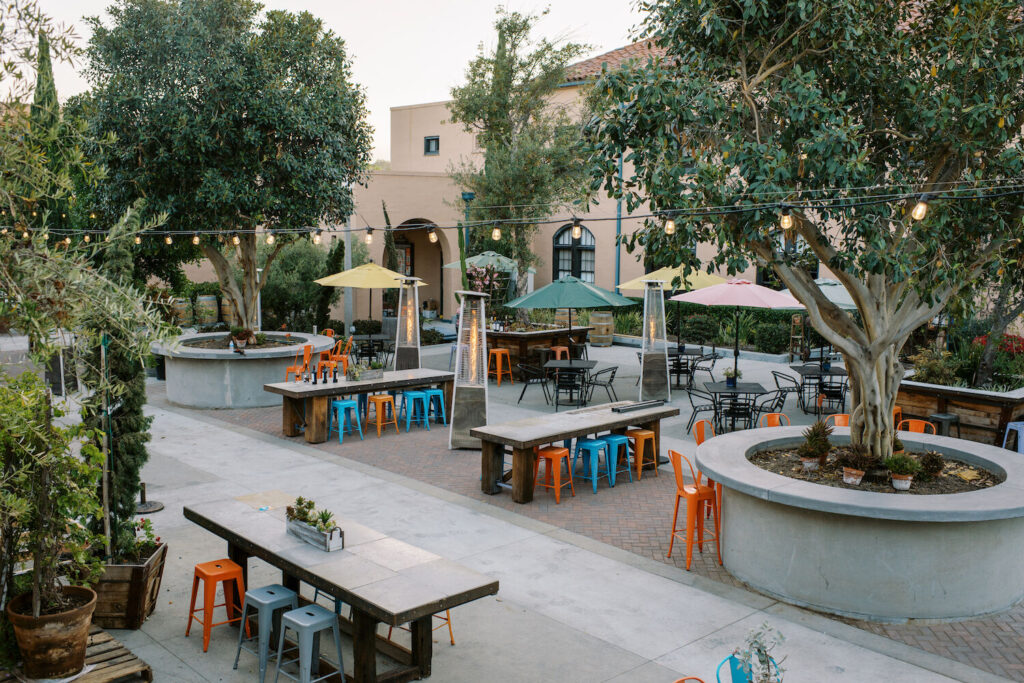
Rady Transitional Housing – main
A mom inherits a neverending list of concerns. Imagine struggling to raise an infant born with multiple medical issues at the height of COVID-19 restrictions.
In the waning months of 2020, Ebony and her daughter, Emaniy, were living in a 2007 Ford Fusion, homeless and running out of couchsurfing options. They slept in the car while parked in a secure lot run by Jewish Family Services’ Safe Parking Lot program. Ebony insulated the car’s windows with blankets. She made a bed for her daughter on the back seat on the driver’s side, and she slept reclined in the passenger seat.
That’s where case manager Colette Mackengel found them. Ebony had applied to The Salvation Army’s Door of Hope, where Mackengel helps take in and oversee clients in dire need.
Admission to Door of Hope’s transitional housing program is first-come, first-served. Mackengel found Ebony on the list, called her, and screened her. She was deemed a perfect fit for Door of Hope’s new Rady Residence.
The New Rady Residence
The Salvation Army has been providing resources for people experiencing homelessness for more than 150 years, including 130 years in San Diego.
Lieutenant Colonel Lee Lescano is the organization’s divisional secretary in San Diego County. He’s been a part of The Salvation Army for 33 years. “We believe in a holistic approach to homelessness,” he says. “You need to get a roof over someone’s head, and then the healing can begin.”
Door of Hope has been helping single mothers in San Diego since 1931. The campus moved to Kearny Mesa in the 1960s. The Rady Residence on the Door of Hope campus quietly opened its doors in October 2020. The pandemic squelched any grand opening celebration. An official celebratory fete was slated for October 2021.
Four older structures were demolished to make way for construction of the four-story residence. The 37,900-square-foot building provides 32 residential units and a total of 136 beds (split into one-, two-, and three-bedroom setups). There’s also a housing services wing, activity room, playroom, and offices.
Philanthropist Ernest Rady and his wife, Evelyn, donated $50 million to The Salvation Army to build the residences in Kearny Mesa, and for another project downtown that is still seeking additional funding.
“We’re pleased to have been able to expand our services,” Lescano says. “Up to this last year, it was shelter, transitional living, and bridge housing for women and children. Now, for the first time, it’s for complete families—men, women, and children at the Rady Residence.”

Rady Transitional Housing – 2
Living in the Rady Residence
Emaniy made tremendous strides after moving into the Rady Residence, Ebony says: “When we were living in the car, she would wake up crying a lot—she would hardly wake up at night after we moved into the residence and she slept in her own bed. She really responded to it.”
Emaniy still has a few hills to climb. She was born preterm at 20 weeks, and weighed less than two pounds. Ebony recalls holding her newborn in the palm of one hand. The baby was in the neonatal intensive care unit for 63 days. Her doctors feared she wouldn’t live—much less walk. Emaniy has beaten many of the medical odds she faced, but still has chronic lung disease and asthma. Early in her young life, three different therapists were coming to the Rady Residence each weekday morning.
The Rady Residence provides wraparound services—a crucial factor that boosts tenants’ chance of long-term success and their ability to move on from temporary housing. Ebony could access caseworkers and their guidance—not to mention diapers, wipes, and baby shoes.
Expanding Programs
One of the biggest changes to The Salvation Army programs at the Rady Residence is the possibility for admittance of men. In the past, these services were open only to single mothers and children. Now, single fathers and couples with children are considered.
It’s only been a year in practice. So far there hasn’t been a large number of men admitted, but there have been some, and Lescano says it’s been smooth going.
The goal, of course, is to keep families in need together, when possible. And the big-picture goal for all residents accepted to the program is to help them get themselves ready for permanent housing.
Moving to Permanent Housing
After roughly six months in the Rady Residence, Ebony and Emaniy were moved into the Rapid Rehousing program. Another caseworker tasked Ebony with finding herself a one-bedroom apartment, and she found a place in El Cajon. A Rapid Rehousing voucher is applied to her rent, and she’s essentially now in permanent housing.
Emaniy is still seeing therapists. And Mackengel, Ebony’s original caseworker, still checks in to make sure all is well with mom and daughter.
“We’re taking it one step at a time,” Ebony says. “We’re moving in the right direction. Homelessness is awful—I wouldn’t wish that on my worst enemy.”
Staying in the Rady Residence proved to be a transformative experience.
PARTNER CONTENT
“Being there let me get settled and get therapists in place for my daughter,” Ebony says. “And take care of my health issues, too. The Rady campus was a godsend for us.”












